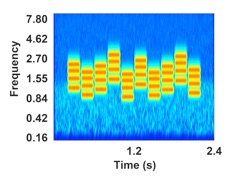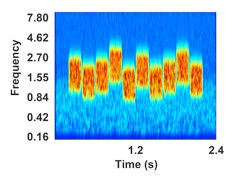Download all of the stimuli for our pitch localizer.
The stimuli are designed to effectively localize pitch regions and to work well with Sensimetrics Earphones. Sensimetrics earphones are widely used in auditory neuroimaging because they are small, MR-safe, and provide hearing protection via screw-one earplugs. However, the earphones are less linear than most high-end audio devices, and can produce substantial distortion products (see our poster for a description of their distortion characteristics).
There are two types of stimuli: harmonic tones and frequency-matched gaussian noise. An example of each is given below:
The harmonic stimuli have been carefully designed to produce minimal cochlear and earphone distortion at SPL levels of 75 dB or below. Background noise is used to energetically mask the low-amplitude DPs produced (evident in the ‘cochleograms’ above, at low frequencies). We have generally found different pairs of Sensimetrics earphones to have similar distortion levels, although distortion levels can rise if the earphones become damaged with continued use.
We have recently submitted a manuscript documenting the acoustic properties of cochlear and Sensimetrics earphone DPs, their effects on cortical responses, and describe how these stimuli can be used to identify pitch-responsive regions while avoiding distortion confounds. We have validated that these stimuli effectively identify pitch-responsive regions in both individual subjects (see Figure 7 of our paper) and across a large cohort of subjects (N=21) using a whole-brain, group analysis (Norman-Haignere et al., submitted).
All of the harmonic and noise stimuli vary in frequency/pitch because we have found this increases the overall response of pitch regions (see Figure 8 of our paper). The sound level of the noise is 5 dB higher than the level of the tones because this approximately equates their perceived loudness.


